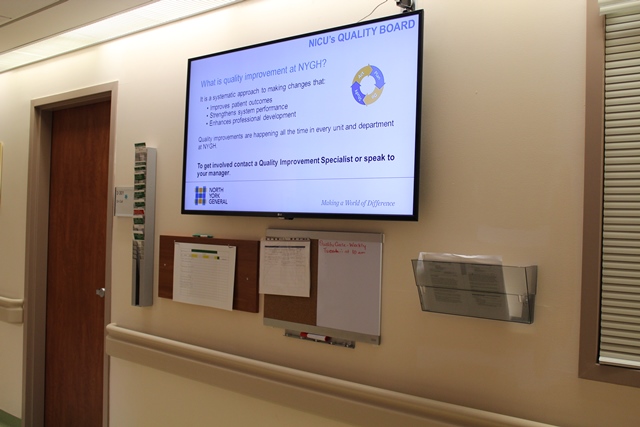
By Jennifer Quaglietta and Talha Hussain
North York General Hospital (NYGH) has placed a strong emphasis on continuous quality improvement for well over a decade. This culture has made NYGH a leader in adopting health care information technology that has significantly improved patient safety and the quality of care we provide.
One of the building blocks to successful quality improvement is measurement and reporting back. Several years ago paper-based Quality Boards were launched on every patient unit along with support services program to provide frontline staff (clinical team managers, unit coordinators, nurses, nurse educators and allied health staff) with recent hospital data related to patient safety and quality.
In discussions with management, North York General’s Quality Improvement Office became aware the Quality Boards were not being used regularly because of limited real-estate, low visual appeal and infrequent data updates.
The Quality Improvement (QI) team decided to apply their own techniques to the Quality Boards and conducted a Plan-Do-Study-Act (PDSA) cycle to evaluate and improve the interactivity of the boards. During the planning phase of the PDSA it was made very clear that the biggest gap with the existing quality boards was the lack of real-time data.
Working with staff, and knowing how successful the adoption of health care technology has been in the hospital, the recommendation was made to evolve the Quality Boards from a paper-based board to an electronic one. Electronic quality boards (eBoards) give NYGH the capability to share the most current patient safety and quality data that is specific to each unit or program. The first pilot of the eBoards took place in 2015 on a respiratory medicine unit. The pilot unit’s operating framework considered the following:
- Impactful and value-added metrics
- Length of quality circle time
- Appropriate location
- Day and time for conducting quality circles
- Desired support structure
Leadership and staff welcomed the new approach, and within months, nineteen eBoards were launched across the hospital, in both clinical and non-clinical departments.
Following the launch, members of the QI team were assigned to support every department and local unit on a weekly basis to help with refreshing the data, organizing the quality circles, and ensuring that both technical and QI expertise was available.
One year later, a rapid cycle evaluation (part of the Study phase of the PDSA cycle) of the nineteen eBoards was held to judge the effectiveness of the new boards. The QI team evaluated how effectively the eBoards facilitated interdisciplinary discussion among frontline staff, and how well they drove evidence-based action plans to improve unit-specific patient safety and quality indicators.
The QI office conducted organization-wide rounds to collect and share feedback from the units. This included best practice examples, as well as areas for improvement or opportunities for further investigation. Some gains were realized from going to a fully electronic system, yet there were still gaps in the new model, including:
- “Data provided on a monthly basis is reported with a 1-2 month delay”
- “Quality circles take too long and keep us away from patient care”
- “The video slide lags when running a quality circle”
- “The slides change too quickly, making it difficult to read the content”
Based on this feedback all slides were set to 15 second pauses, and the QI team decided to conduct an external scan of other hospitals using eBoards.
The learnings from our focus groups and external scans led to the development of a new hybrid model where paper and electronic platforms are merged to maximize benefits. It was clear staff wanted more ownership in the QI efforts which were part of the paper platform, but they also enjoyed the electronic platform’s user friendliness for patients and families. Using Roger Martin’s Integrative Thinking approach, the QI team was able to design a solution without compromise – giving back customization to the units.
The hybrid approach included switching from outcome based metrics to process metrics. The units first received a demonstration from the QI team using a physical prototype. The prototype included the option to incorporate a visual management system using Kamishibai cards. Kamishibai cards are a form of storytelling that uses visual cards to perform audits for a particular process. A series of cards are placed near the QI boards and one is randomly selected for an audit to ensure safety and quality checks are performed. This allows staff to visually see what processes or metrics where unsatisfied and provide an opportunity in real time to make a change to the design of a system or process.
Additionally, the prototype allows staff to run a ten minute quality circle, or huddle, daily instead of weekly to discuss or monitor a single safety or quality metric such as the number of falls per day, number of cribs with fresh linens or completed Braden scale for patients at risk for developing pressure injuries. Finally, the prototype also provided space for an optional white board and cork board so teams can document and share action plans which all staff, regardless of their shift, can contribute to.
Once staff were satisfied with their customization selection, the QI team supported units through the transition to the eBoard and continues to support all nineteen eBoards and quality circles on a weekly basis.
Currently, five units have gone live with the hybrid model, with another seven planned over the next two months. Initial feedback has been positive in terms of being able to catch safety concerns earlier and developing mitigating strategies during the quality huddle.
Jennifer Quaglietta is the Director of Patient Experience, Quality Transformation and Patient- and Family- Centred Care at North York General Hospital and Talha Hussain is a Quality Improvement Specialist with North York General Hospital.

